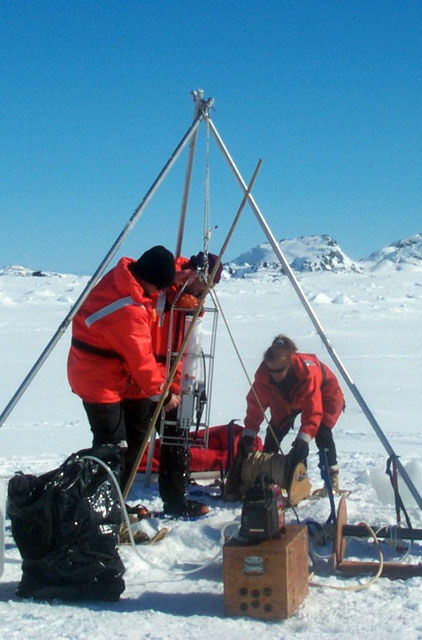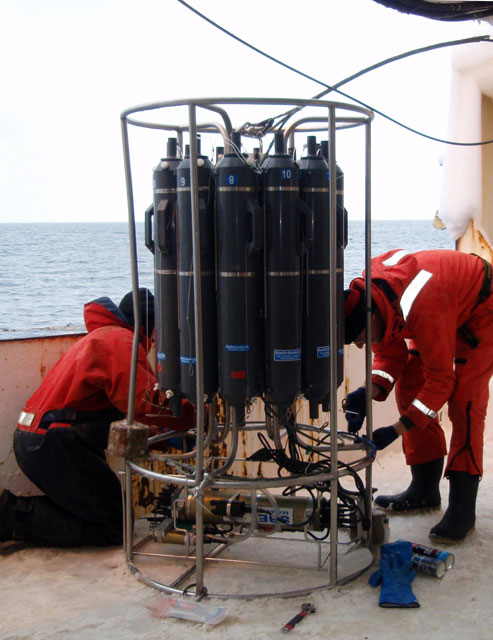|
Bipolar bacteriaScientists find diverse microbial communities between Antarctic and ArcticPosted October 12, 2012
The Arctic and Southern oceans are both high-latitude environments characterized by the seasonal ebb and flow of sea ice and the sun — but they’re poles apart when it comes to the microbial communities that make their home in those frigid waters. An international team of scientists reported in the early nline edition of the Proceedings of the National Academy of Science this month that only 25 percent of the taxonomic groups identified by genetic sequencing that are found at the surface are common between the two polar oceans. The differences were less pronounced among microbes deeper in the ocean, with 40 percent commonality between the two oceans. “We believe that differences in environmental conditions at the poles and different selection mechanisms were at play in controlling surface and deep ocean community structure between polar oceans,” said Alison Murray One of the most notable differences in environmental conditions between the two polar oceans is freshwater input. In the Southern Ocean, glacial meltwater accounts for most of the freshwater that flows into the systems. In contrast, the Arctic Ocean receives much bigger pulses of freshwater from several large river systems with huge continental drainage basins, in addition to glacial meltwater. The group found that the differences between the poles were most pronounced in the microbial communities sampled from the coastal regions. “This likely is a result of the significant differences in freshwater sourcing to the two polar oceans,” said Jean-François Ghiglione, lead author of the article and professor at the Observatoire Océanologique While the surface microbial communities appear to be dominated by environmental selection, such as through the freshwater inputs, the deep communities are more constrained by historical events and connected through oceanic circulation, providing evidence for biogeographically defined communities in the global ocean, according to the authors. The study was the result of an international effort coordinated by Murray involving national polar research programs from six countries — Canada, France, New Zealand, Spain, Sweden and the United States. The collaboration was made possible through research supported by the International Polar Year 
Photo Credit: Friederike Heinrich
This picture shows Ross Sea bacteria from a 2007-08 expedition. The sample was taken from an in situ onboard experiment that was designed to compare the bacterial community structures under light and dark conditions. This picture shows the total bacterial community after 21 days of light incubation.
“The collective energies required to bring this study to fruition was remarkable,” Murray said. “Through using similar strategies and technologies from sample collection through next-generation sequencing, we have a highly comparable, unprecedented dataset that for the first time has really allowed us to look in depth across a relatively large number of samples into the similarities of the microbial communities between the two polar oceans.” The team compared 20 samples from the Southern Ocean and against 24 from the Arctic from both surface and deep waters. They also included an additional 48 samples from lower latitudes to investigate the polar signal in global marine bacterial biogeography. The researchers specifically compared samples from coastal and open oceans and between winter and summer, to test whether or how environmental conditions and dispersal patterns shape communities in the polar oceans. Samples were processed and analyzed using an identical approach, based on a special technique of DNA sequencing called pyrosequencing, involving more than 800,000 sequences from the 92 samples. “Our analyses identified a number of key organisms in both poles in the surface and deep ocean waters that are important in driving the differences between the communities,” Murray said. “Further research is needed to address the ecological and evolutionary processes underlying these patterns.” NSF-funded research in this article: Alison Murray, Desert Research Institute, Award No. 0632389 |



For USAP Participants |
For The Public |
For Researchers and EducatorsContact UsU.S. National Science FoundationOffice of Polar Programs Geosciences Directorate 2415 Eisenhower Avenue, Suite W7100 Alexandria, VA 22314 Sign up for the NSF Office of Polar Programs newsletter and events. Feedback Form |




